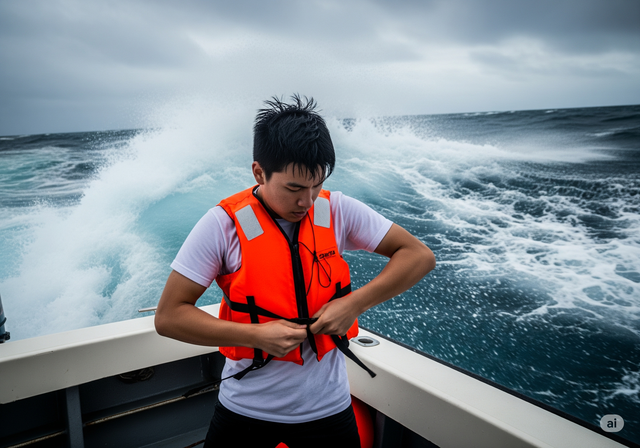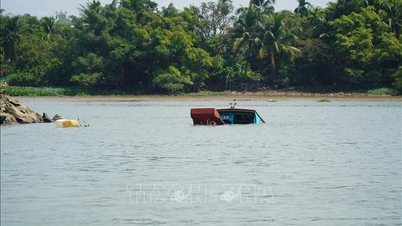Here, rowing coach Travis Lund, Director of Treasure Island Rowing Center (USA) and fitness and health coach Yvonne Mo (USA), share tips for surviving in case of an emergency boat or ship capsize.
Things you should know
Stay calm, wear a life jacket (if not already wearing one), check the number of people and signal for help using whatever means you have.
Keep everyone together and stay in the boat unless you are sure you can swim to shore. A capsized boat can still float if it is not damaged, according to Wikihow .
When an accident happens at sea, quickly put on a life jacket if you haven't already, and stay calm - Photo: AI
How to survive a capsized boat
Here are the steps you need to take to survive if your boat or ship capsizes.
Step 1: Quickly put on a life jacket if you haven't already, stay calm.
Step 2: If you have time, send out a distress signal. Find a way to send out a distress signal. Blow a whistle, light a distress signal, or use flares if available.
Step 3: Take a roll call to ensure no one is missing. The first thing to do when a ship capsizes is to check on everyone on board and make sure no one is injured or separated.
Step 4: Stick to the boat. Even if a boat capsizes, it takes time to sink. The most important thing is to stay on the boat if it is still afloat. This greatly increases your chances of being rescued. A boat is more visible than a person floating in the ocean.
If the boat or ship is still afloat, try to climb onto the hull to minimize your exposure to the water. Water loses body heat 25 times faster than air.
Stay close to the boat to avoid drowning and do not try to swim to shore. Unless you are 100% sure you can swim to shore, do not abandon the boat. It is safer to stay with your group and wait for rescue.
Step 5: Maintain proper posture in the water. The biggest risk in the water is hypothermia. Conserve body heat and stay afloat by adopting the “heat loss reduction” position: Tuck your chin in, fold your arms over your chest, cross your legs and pull your knees up while leaning back slightly. This will help you float better and stay warmer longer. If possible, hold onto the boat and maintain this position.
Step 6: Wait for rescuers to arrive and encourage everyone to stay calm. Stay calm and encourage everyone. Finally, always check the weather forecast before setting out. It is best to never set out if a storm is coming, according to Wikihow.
Source: https://thanhnien.vn/chuyen-gia-huong-dan-cach-de-song-sot-khi-bi-lat-tau-thuyen-185250720203437192.htm



![[Photo] Ho Chi Minh City Youth Take Action for a Cleaner Environment](https://vphoto.vietnam.vn/thumb/1200x675/vietnam/resource/IMAGE/2025/11/04/1762233574890_550816358-1108586934787014-6430522970717297480-n-1-jpg.webp)

![[Photo] Panorama of the Patriotic Emulation Congress of Nhan Dan Newspaper for the period 2025-2030](https://vphoto.vietnam.vn/thumb/1200x675/vietnam/resource/IMAGE/2025/11/04/1762252775462_ndo_br_dhthiduayeuncbaond-6125-jpg.webp)
![[Photo] The road connecting Dong Nai with Ho Chi Minh City is still unfinished after 5 years of construction.](https://vphoto.vietnam.vn/thumb/1200x675/vietnam/resource/IMAGE/2025/11/04/1762241675985_ndo_br_dji-20251104104418-0635-d-resize-1295-jpg.webp)
![[Photo] Ca Mau "struggling" to cope with the highest tide of the year, forecast to exceed alert level 3](https://vphoto.vietnam.vn/thumb/1200x675/vietnam/resource/IMAGE/2025/11/04/1762235371445_ndo_br_trieu-cuong-2-6486-jpg.webp)
































































































Comment (0)